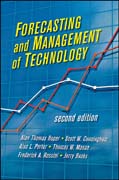
Forecasting and management of technology
Porter, Alan L.
Cunningham, Scott W.
Banks, Jerry
Published in 1991, the first edition of Forecasting and Management of Technology was one of the leading handful of books to deal with the topic of forecasting of technology and technology management as this discipline was emerging. The new, revised edition of this book will build on this knowledge in the context of business organizations that now place a greater emphasis on technology to stay on the cutting edge of development. The scope of this edition has broadened to include management of technology content that is relevant to now to executives in organizations while updating and strengthening the technology forecasting and analysis content that the first edition is reputed for. Updated bythe original author team, plus new author Scott Cunningham, the book takes into account what the authors see as the innovations to technology management inthe last 17 years: the Internet; the greater focus on group decision-making including process management and mechanism design; and desktop software that has transformed the analytical capabilities of technology managers. Included in this book will be 5 case studies from various industries that show how technology management is applied in the real world. INDICE: Chapter 1. Introduction. 1.1 About this Book. 1.2 Technology and Society. 1.3 Management and the Future. 1.4 Conclusions. References. Chapter 2.Technology Forecasting. 2.1 What is Technology Forecasting? 2.2 Methodological Foundations. 2.3 Technology Forecasting Methods. 2.4 Conclusion. References.Chapter 3. Managing the Forecasting Project. 3.1 Information Needs of the Forecasting Project. 3.2 Planning the Technology Forecast. 3.3 Team Organization,Management and Communications. 3.4 Success: The Right Information at the Right Time. 3.5 Project Scheduling. 3.6 Conclusions. References. Chapter 4. Exploring. 4.1 Establishing the Context The TDS. 4.2 Monitoring. 4.3 The Stimulationof Creativity. 4.4 Conclusion. References. Chapter 5. Gathering and Using Information. 5.1 Expert Opinion. 5.3 Structuring The Search. 5.4 Preparing SearchResults. 5.5 Using Search Results. 5.6 Developing Science, Technology and Social Indicators. 5.7 Communicating Search Results. 5.8 Conclusions. References.Chapter 6. Analyzing Phase. 6.1 Perspective on Data and Methods. 6.2 Linear Regression and Extensions. 6.3 Growth Models. 6.4 Simulation. 6.5 Monte Carlo Simulation. 6.6 System Dynamics. 6.7 Gaming. 6.8 Software Suggestions. References. Chapter 7. Focusing Phase: Using Scenario Analysis. 7.1 Uncertainty. 7.2 Scenarios. 7.3 Examples and Applications. 7.4 Scenarios: Extensions and Advanced Techniques. 7.5 Conclusions. References. Chapter 8. Economic and Market Analysis. 8.1 The Context. 8.2 Forecasting the Market. 8.3 Forecasting the Economic Context. 8.4 Forecasting in an Institutional Context. 8.5 Conclusion. References. Chapter 9. Impact Assessment. 9.1 Impact Assessment in Technology Forecasting. 9.2 Impacts on Technology and Impacts of Technology. 9.3 A Comprehensive Approach to Impact Assessment. 9.4 Impact Identification. 9.5 Impact Analysis. 9.6 Impact Evaluation. 9.7 Conclusion. References. Chapter 10. Cost-Benefitand Risk Analysis. 10.1 Opportunity Costs and Choices. 10.2 Cost-Benefit Analysis. 10.3 Accounting for Risk and Uncertainty. 10.4 Concluding the Focusing Phase. References. Chapter 11. Implementing the Technology. 11.1 Forecasting Continues. 11.2 Implementation Issues. 11.3 Strategic Planning for Technology Implementation. 11.4 Selecting From Alternative Implementations of the Technology. 11.5 Technology Roadmapping. 11.6 When Plans and Forecasts Fail. 11.7 Summary and Concluding Observations. References. Chapter 12. Managing the Present From the Future. 12.1 The Overall Approach. 12.2 Selecting Methods and Techniques. 12.3 Alternative perspectives. 12.4 Learning From Past Forecasts and Assessments. 12.5 Visions. 12.6 A Final Word. References. Chapter 13. Case Study onForecasting Dye-Sensitized Solar Cells. 13.1 Framing the Case Study. 13.2 Methods. 13.3 The Rest of the Story. References.
- ISBN: 978-0-470-44090-2
- Editorial: John Wiley & Sons
- Encuadernacion: Cartoné
- Páginas: 352
- Fecha Publicación: 22/06/2011
- Nº Volúmenes: 1
- Idioma: Inglés
